Did One of the Feather Boas Start Shedding?
Did One of the Feather Boas Start Shedding?
A True Accounting of a Natural Event
By Bill Willis
June, 2017
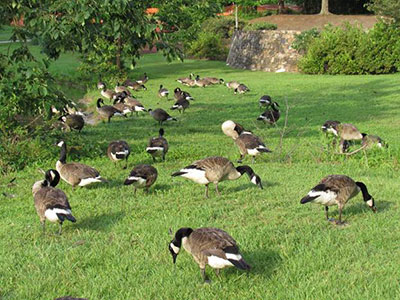
Courtesy of Bill Willis
It was a quiet and sunny day at Discovery Lake Beach and the flock had gathered at the Memorial Garden to preen and socialize. A flock of seventy Canada geese were staying local and not traveling north as the breeding season ended. It’d been a hectic winter and spring, and needless to say, many feathers had been ruffled along the way. All this fuss about pairing, mating, starting a family, and even using public toilets took a toll on outlook and appearance. It was time for a break.
Then, why were the geese still hanging around campus? Shouldn’t they have moved on? Not necessarily, for most of these geese are North Carolina residents. Their parents established residency with the assistance of the Federal Migratory Bird Act of 1918. That act granted them the right to return to their birth place to raise their families. No Wailing, No Wall. Plus, this year’s goslings wouldn’t be able to fly until the middle of July when they’d become airborne certified.
Body, wing, and tail feathers were scattered about campus. If these feathers were seen at any other time of year, the concern would be predation of the flock. But during late June and July, there is another reason for feather dusting and that is molting.
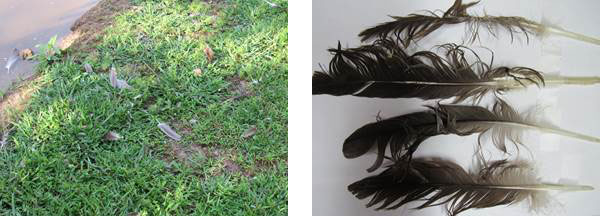
Geese undergo a single annual molt, the shedding of their flight feathers or primaries, beginning in June. They are among the waterfowl that replace all their flight feathers at one time. This is termed a “simultaneous wing molt”. On the other hand, perching birds lose a few feathers at a time, this being called a “sequential molt” and retain flight ability. During early June, migratory birds usually fly to Canada’s wetlands and molt there where the days are long and the food is plentiful. These birds will return in September joining up with other birds going south. The exact timing can vary between species and within species, so variations and exceptions are expected.
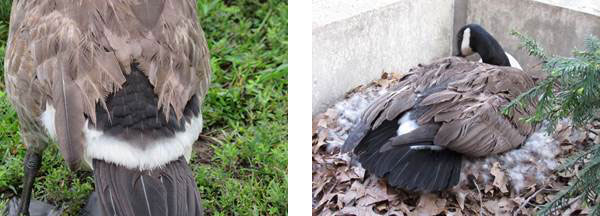
In the meantime, the resident geese find a safe gated community with good security and amenities. There they gaggle, lay back, shake a tail feather, and make the best of the local cuisine and accommodations. The loss of feathers renders them flightless, and consequently susceptible to harm. Per the bird-a-holics, non-breeding juveniles (1-3 years) and non-nesting adults are the first to molt, followed by the breeder pairs. During this period, goslings will attain their first primary flight feathers.
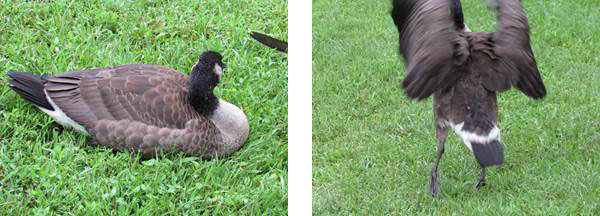
The birds become more social, walk around together, dropping a few feathers here and there as well as taking a load off when necessary. The lake is a very important safe place now and the birds are never too far away. Flights are re-scheduled about six weeks after the molt begins.
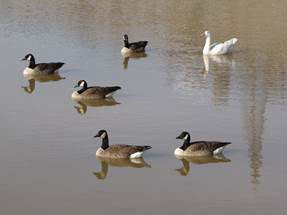
Geese will continue to consume massive quantities of grass (1-5lbs daily), seed heads, and various small critters. This molting rejuvenation period is nutritionally demanding to replace all the protein lost in the feathers. In addition, females must restore nutrition from egg laying. The weight of an adult goose is between 20 and 25 pounds; it takes much energy to maintain flight.
Once the new feathers are in, the geese will have better insulation, flotation, camouflage, general appearance, attitude, and sex appeal.
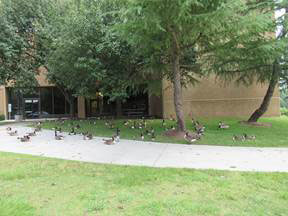
With the recent interest shown in EndNote’s nested groups and instructions on migrating to Mendeley, the Library is considering adding a new “migratory flight” class to its excellent developmental series. Highly qualified flight instructors will present the material, free of charge to residents. Topics cover “V” wedge formation,foul-weather maneuvering, map and star navigation, new honking signals, advanced social moves, core exercise cross training, vertical takeoffs/landings, plus the merits of broadening horizons by spreading your wings. This instruction should be valuable in reducing the local “pond hopping” and expand the number of birds in other gene pools.
By August there should be a change in goose behavior as they once again take to the skies, but now with a new sense of adventure thanks to NIEHS.



